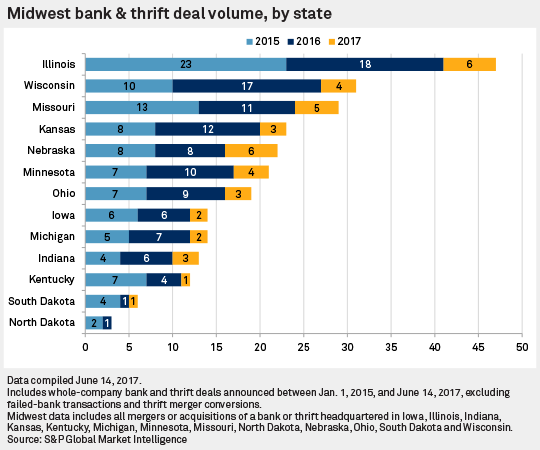In January of this year, we launched Bank Strategy Briefing with two M&A-related articles. The first article analyzed bank M&A activity in Wisconsin during 2016, which marked the busiest M&A year in Wisconsin in 20 years and the culmination of a 3-year run-up in M&A activity. In the second article, we predicted that bank M&A activity in Wisconsin would return to more historically normalized levels in 2017.
Having recently crossed the halfway point for 2017, we revisited our prediction, and it is turning out to be accurate (at least for the moment). Over the last 25 years, Wisconsin has averaged between seven and eight whole bank deals annually. As of June 30, 2017, there have been four whole bank deals announced, putting our state on pace for eight deal announcements for the year. If this trend holds, it would represent a departure from the run-up in bank M&A that Wisconsin saw in 2014 (9 deals), 2015 (10 deals), and 2016 (17 deals).
Interestingly, this trend appears to be consistent across much of the Midwest. The following chart1 shows that 2017 M&A activity in the Midwest is generally on pace to lag behind activity in 2015 and 2016.

We think the decrease in bank M&A activity can be explained by several factors, including those we pointed out in our previous articles. We also continue to believe that there is a possibility that M&A activity will accelerate again—or at least maintain historical levels—over the next couple of years, and here are a few reasons why:
- Interest rates and regulatory relief will become sums certain. At some point, the interest rate and regulatory environment will become more certain. For boards taking a “wait and see” approach, such certainty should allow them to better analyze their situation as a buyer or seller and act on it.
- Deal multiples are increasing. The median deal value to tangible common equity for Midwest bank M&A so far in 2017 is between 140-150% as reported by SNL Financial. That compares to between 120-130% in 2016. Thus, deal pricing alone may start steering more banks to sell.
- Deposits will make rural banks more valuable. As we have previously pointed out in Bank Strategy Briefing, deposits are likely to start becoming the primary driver for more M&A activity, which will create more interest from banks in high loan growth markets to pursue deposit-rich banks in contiguous rural markets. In addition to whole bank deals, this desire for deposits may also spark an increase in branch transactions.
Of course, the decision to pursue an M&A strategy as a buyer or seller is nuanced and bank specific, such that no “trend” should ever determine a particular bank’s strategy. We recommend that community bank boards and management teams continue to monitor M&A activity as a way to assess threats and opportunities and to make informed decisions for the benefit of shareholders.
1 Source: S&P Global Market Intelligence LLC. Contains copyrighted and trade secret material distributed under license from SNL. For recipients’ internal use only.